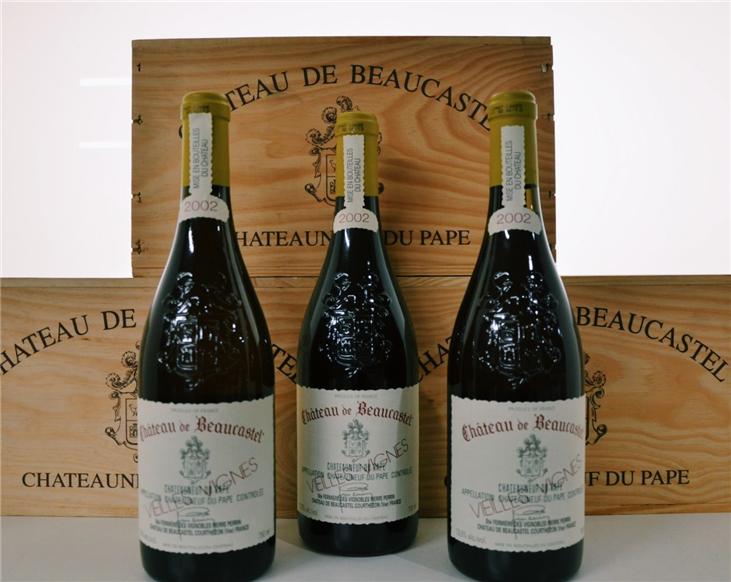One of the most renowned appellations in France must be Châteauneuf du Pape. The AOC is located around the village Châteauneuf du Pape, in the southern Rhône Valley. Together, the winegrowers produce more wine than the entire northern Rhône Valley. Its deep history, distinctive terroir, rich grape varieties and passionate winemakers create a unique blend that makes your wine-loving heart skip a beat.
The history of Châteauneuf du Pape
The story of Châteauneuf du Pape started in 1309 when Pope Clement V relocated the office of the pope to Avignon. Translated ‘Châteauneuf du Pape’ means ‘The Pope’s New Castle’. Clement V was a true lover of Burgundy wines but also promoted viticulture in the surrounding area of the new office. He’s the man who discovered the special soil of Châteauneuf du Pape.
His successor John XXII spent his summers in Châteauneuf du Pape and invested in better viticultural practices, erected a castle and planted vines. The wines were known as ‘Vin du Pape’, and by 1344, 45% of Châteauneuf de Pape was all about producing wine.
Although the first vines in Châteauneuf du Pape were planted in Gallo-Romans time, the popes of the 14th century gave the winegrowing in the region a boost. When they moved the office of the pope back to Rome at the end of the century, wine production didn’t stop. Many citizens owned a small parcel and continued production.
At the end of the 18th century, the region became famous for the quality of its wines. But, in 1866 disaster stroke. The Phylloxera epidemic ruined most of the vineyards, and it took several decades for wine growers to rebuild the vineyards. It had to happen step by step as the wine was sold for little money and replanting cost a lot of money.
The appellation Châteauneuf du Pape
In 1924 Châteauneuf du Pape applied for official appellation status. Baron Pierre Le Roy, who owned several famous châteaus and was also a lawyer, was involved in writing down the first draft of rules.
In 1936 the INAO, Institut National des Appellations d’Origine, officially created the Châteauneuf du Pape appellation and cast rules about terroir, grape varieties, vine density and age, irrigation, watering, harvesting … in concrete. For example, harvesting must be done 100% by hand. A meticulous task but one of the reasons why the wines of Châteauneuf du Pape are of exquisite quality.
The appellation is divided into five communes: Châteauneuf du Pape, Orange, Courthézon, Sorgues and Bédarrides. Châteauneuf du Pape takes up 53% of the appellation. Each commune is further divided into 134 different Lieux-Dits or specific places. Most estates are rather small: only 24 estates are 30 hectares or larger.
The terroir and climate of Châteauneuf du Pape
Soil and subsoil can be very different but in general, the land in the west, where the commune Châteauneuf du Pape is located, is filled with rocks, stone, sand, clay and pebbles. During warm summer days, the rocks absorb the heat and radiate it back to the vines during colder nights. This is perfect for the fruit to ripen and eventually results in full-bodied and intense wines. But there are also parts with more limestone, which is ideal for white wines.
In the east, you’ll find less stony soil and more sand, marl and clay. The clay, in particular, is responsible for the rich and concentrated wines this part of Châteauneuf du Pape is famous for. The south has shallow sand and clay soil on a subsoil of gravel and the land of the north is a mix of sand, red and grey clay and limestone.
Some vineyards in the Southern Rhône are more than 100 years old. These old vines produce a much lower yield but their level of concentration is more intense and gives depth to the wines.
Châteauneuf du Pape enjoys a Mediterranean climate, which is characterised by hot and dry summers and wet winters that can be freezing cold. The mistral winds blow fierce and it’s proven it is conducive to the quality of the vines and grapes. They keep the air, vines and grapes clean, and cool down the soil and vines during summer. Finally, there are less rainy days and more sunny days in Châteauneuf du Pape than in any other wine region.
The grapes of Châteauneuf du Pape
There are thirteen grape varieties permitted in the red and white wines of Châteauneuf du Pape: Bourboulenc, Cinsault, Clairette, Counoise, Grenache, Mourvèdre, Muscardin, Picardan, Picpoul, Roussanne, Syrah, Terret Noir and Vaccarèse.
In their search for top quality, generations of winemakers researched different grape varieties. One of them was Ducos, who owned La Nerthe and was a worthy successor of the Marquis Tulle de Villefranche. After the Phylloxera epidemic in the late 19th century, he grew ten different varieties in his own vineyard looking for only the best.
In 1936, when the rules of the appellation Châteauneuf du Pape were decided, ten varieties became allowed. Later, three more (Picardan, Roussanne and Terret Noir) were added.
Most winemakers cultivate around four grape varieties in their vineyards but there is one who produces all thirteen grapes: Château de Beaucastel.
The main grape variety in Châteauneuf du Pape is Grenache. Almost 75% of all vineyards are planted with Grenache. The grape contributes warmth and strength, while other varieties like Syrah, Cinsault and Mourvèdre add balance to the wines of Chêateueuf du Pape.
The wines of Châteauneuf du Pape
No wine cellar is complete without a fine selection of Châteauneuf du Pape wines. Discover our wide range Châteauneuf du Pape wines in our online shop. Don’t hesitate to contact us for personal assistance.





